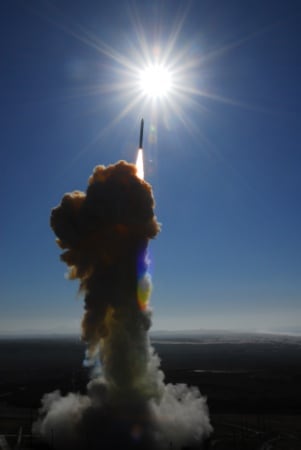WASHINGTON — The Ground-based Midcourse Defense System completed a successful non-intercept flight test designed to evaluate the performance of redesigned thrusters in its interceptor's kill vehicle, the Missile Defense Agency announced Thursday night.
The agency, along with the US Air Force 30th Space Wing, the Joint Functional Component Command for Integrated Missile Defense and US Northern Command, launched a long-range ground-based interceptor from Vandenberg Air Force Base, California, and was able to evaluate alternate divert thrusters in the new version of the GMD's ground-based interceptor.
The GMD system is designed to protect the homeland from possible ballistic missile threats from North Korea and Iran.
The divert thrusters were redesigned to address fundamental problems experienced in the previous version of the Exoatmospheric Kill Vehicle (EKV) – a key component of the interceptors designed to destroy targets in high-speed collisions after separating from a booster rocket.
The EKV struggled in tests and the acquisition plan for more ground-based interceptors – a total of 44 in California and Alaska – was threatened after interceptor test failures in 2010 and 2013. In the July 2013 test, the kill vehicle failed to separate from the booster rocket. In June 2014, however, the agency notched a successful intercept test, bringing its success record to four of seven tests and saving the program.
During the test Thursday, "a target representing an intermediate-range ballistic missile was air-launched from a US Air Force C-17 aircraft over the broad ocean area west of Hawaii," MDA described.
An Raytheon-manufactured AN/TPY-2 radar in forward-based mode at the Pacific Missile Range Facility in Hawaii detected the target and sent the tracking information to the battle management system. A Raytheon-made Sea-Based X-band radar, in the ocean northeast of Hawaii also identified and tracked the target.
The GMD system received the tracking data and identified a fire control solution to engage the target. The test also demonstrated technology to discriminate countermeasures carried by the target missile, according to the agency.
When the GBI was launched from Vandenberg, the kill vehicle performed "scripted maneuvers to demonstrate performance of alternate divert thrusters," the MDA states. "Upon entering terminal phase, the kill vehicle initiated a planned burn sequence to evaluate the alternate divert thrusters until fuel was exhausted, intentionally precluding an intercept."
Information from the test will be used to increase confidence of future intercept performance, the agency notes.
Aerojet Rocketdyne, the designer and manufacturer of the "liquid Divert and Attitude Control System (DACS) on the EKV, said in a statement that the successful test represents three years of "hard work and dedication" on design improvements made at the company's Los Angeles site.
"On this flight, we validated key design improvements in the divert and attitude control system, demonstrating improved performance, reliability and producibility," Michael Bright, Aerojet Rocketdyne vice president of missile defense and strategic systems, said in the statement.
Three companies are also in the midst of redesigning the GMD kill vehicle that can take out multiple warheads with a single interceptor, completing their first program planning reviews with the MDA in November, which marked a critical step toward determining key elements of the designs.
Raytheon, Lockheed Martin and Boeing were all awarded $9.7 million contracts in August by the MDA to work on designs.
Email: jjudson@defensenews.com
Twitter: @JenJudson
Jen Judson is an award-winning journalist covering land warfare for Defense News. She has also worked for Politico and Inside Defense. She holds a Master of Science degree in journalism from Boston University and a Bachelor of Arts degree from Kenyon College.








